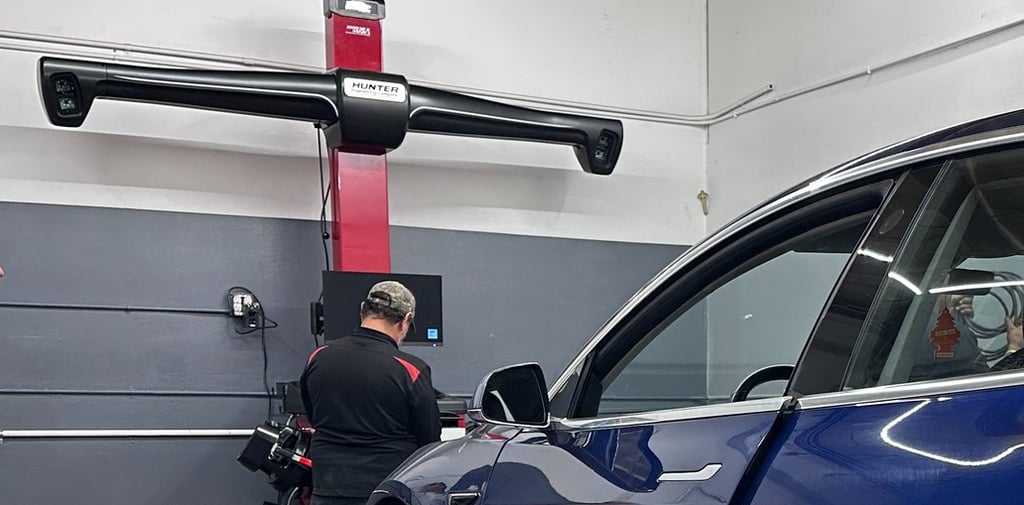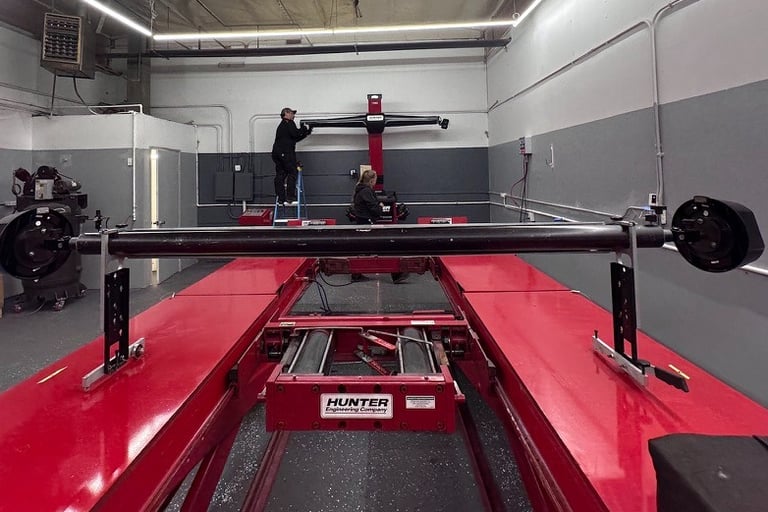Say Goodbye to Misaligned Wheels: Discover the Power of Advanced Alignment Systems
Blog | Northridge drivers, discover the evolution of wheel alignment—from old-school methods to cutting-edge 3D tech—for a smoother, safer ride and longer-lasting tires.
WHEEL ALIGNMENT
George D.
6/15/20256 min read


Picture this: you're cruising down the 118 freeway through Northridge, hands relaxed on the steering wheel, when suddenly your car starts pulling to one side. Your tires are wearing unevenly, your fuel economy has taken a hit, and that smooth ride you once enjoyed has become a frustrating struggle. Sound familiar? You're experiencing the telltale signs of misaligned wheels—a common problem that affects thousands of San Fernando Valley drivers every year.
But here's the good news: the world of wheel alignment has undergone a revolutionary transformation. Gone are the days of guesswork and imprecise adjustments. Today's advanced alignment systems—available right here in Northridge and throughout Los Angeles County—use cutting-edge technology to deliver precision that would have been unimaginable just a few decades ago.
The Hidden Cost of Misaligned Wheels in Northridge
Before we dive into the exciting world of modern alignment technology, let's understand what's at stake for Northridge drivers. Misaligned wheels don't just cause minor inconveniences—they can seriously impact your wallet and safety, especially when navigating the varied terrain of the San Fernando Valley.
Financial Impact:
Premature tire replacement (potentially saving you hundreds of dollars annually)
Increased fuel consumption due to rolling resistance—critical with California gas prices
Accelerated wear on suspension components from pothole-damaged roads
Higher maintenance costs over time
Reduced resale value of your vehicle
Safety Concerns:
Reduced vehicle stability and control on winding canyon roads
Longer braking distances in emergency situations
Increased risk of tire blowouts on hot Valley days
Compromised handling during California's rainy season
Comfort and Performance:
Steering wheel vibration and pulling during daily commutes
Uneven tire noise affecting ride quality
Poor vehicle tracking on straight highways
Reduced fuel efficiency—important for long LA commutes
The Technology Revolution: From Strings to Laser Precision
The Old School Approach
Not too long ago, wheel alignment was more art than science. Mechanics relied on:
Simple rulers and measuring tapes
String lines stretched across the vehicle
Basic mechanical alignment racks
Visual estimation and experience
While these methods worked to some degree, they were time-consuming, labor-intensive, and often inconsistent. The margin for error was significant, and achieving truly precise alignment was nearly impossible.
Enter the Laser Age
The introduction of laser alignment systems marked a turning point in automotive service. These systems use focused laser beams to measure wheel angles with remarkable precision:
How It Works:
Laser units are mounted on each wheel
Beams are projected onto reflective targets
Real-time measurements are displayed on computer screens
Adjustments can be made with pinpoint accuracy
The Advantages:
Accuracy down to fractions of a degree—essential for precision vehicles
Significantly faster service times (important for busy Northridge schedules)
Reduced human error and consistent results
Real-time toe, camber, and caster adjustments
Enhanced wheel balancing integration
Local Success Story:
George's Alignment and Brake Service in Northridge, CA, recently upgraded to the state-of-the-art Hunter HawkEye Elite system and reported remarkable improvements. They experienced a 50% reduction in alignment service time and significantly increased customer satisfaction. Local drivers noticed immediate improvements in ride smoothness and vehicle handling, demonstrating the tangible benefits of this advanced technology for San Fernando Valley residents. The shop's investment in the HawkEye Elite system showcases their commitment to providing the most precise wheel alignment services available in the Northridge area.
The 3D Revolution
Just when we thought laser alignment was the pinnacle of precision, 3D scanning technology raised the bar even higher. These advanced systems create detailed three-dimensional models of your vehicle's wheel and suspension geometry.
3D Scanning Benefits:
Unmatched Precision: Detects even the smallest toe-in, toe-out discrepancies
Comprehensive Analysis: Captures camber, caster, and thrust angle simultaneously
Visual Representation: Provides clear before-and-after comparisons for customers
Detailed Reporting: Generates comprehensive alignment specifications reports
Suspension Diagnostics: Identifies worn ball joints, tie rods, and control arms
Meet the Game-Changer: Hunter HawkEye Elite System
One of the most impressive examples of modern alignment technology is the Hunter HawkEye Elite system. This computerized marvel combines the best of 3D scanning with powerful software to deliver unprecedented accuracy and efficiency.
Key Features:
3D Imaging Technology: Creates precise digital models of wheel positioning
Extensive Vehicle Database: Contains specifications for virtually every make and model
Intuitive Interface: Makes complex adjustments simple and straightforward
Real-Time Feedback: Provides instant results during the alignment process
Real-World Results: Northridge auto shops like George's Alignment and Brake Service using the HawkEye Elite system report:
50% reduction in wheel alignment service time
Dramatically improved customer satisfaction scores
Fewer comebacks and warranty claims
Enhanced technician productivity and accuracy
Better integration with tire installation services
The Mobile Revolution: Technology in Your Pocket
Modern alignment technology isn't just revolutionizing the shop floor—it's putting power in your hands too. Mobile apps and software innovations are changing how customers interact with alignment services:
For Mechanics:
Real-time data access and analysis
Step-by-step alignment instructions
Remote diagnostics and troubleshooting
Seamless integration with alignment equipment
For Customers:
Digital alignment reports sent directly to smartphones
Clear visual explanations of adjustments made
Easy appointment scheduling and service tracking
Historical records of alignment services
The Comprehensive Benefits of Advanced Alignment Technology
Enhanced Accuracy and Precision
Modern computerized alignment systems eliminate guesswork, ensuring your wheels are aligned to exact manufacturer specifications. This precision translates to:
Optimal tire wear patterns and extended tire life
Maximum fuel efficiency—crucial for Valley commuters
Superior handling and vehicle stability
Proper steering wheel centering
Extended suspension component life
Speed and Efficiency
What once took hours now takes minutes. Advanced four-wheel alignment systems deliver:
Faster service times (typically 30-60 minutes)
Reduced vehicle downtime for busy professionals
Higher shop productivity and throughput
Same-day service availability
Integration with tire rotation and balancing services
Economic Advantages
The investment in advanced alignment technology pays dividends for Northridge drivers:
Lower long-term maintenance and repair costs
Extended tire life (potentially doubling tire lifespan)
Improved fuel economy—savings of 5-10% on gas
Reduced need for suspension repairs and replacements
Better trade-in value due to proper maintenance
Safety and Performance
Properly aligned wheels are crucial for vehicle safety:
Enhanced stability and control
Improved braking performance
Better handling in emergency situations
Reduced risk of tire-related incidents
What This Means for You
As a driver, these technological advances translate into tangible benefits:
Immediate Benefits:
More accurate alignments in less time
Better understanding of your vehicle's condition
Improved ride quality and handling
Greater confidence in service quality
Long-Term Value:
Significant savings on tire replacement
Reduced fuel costs
Lower maintenance expenses
Enhanced vehicle safety and reliability
The Future of Wheel Alignment
The evolution of alignment technology shows no signs of slowing down. Emerging trends include:
Artificial Intelligence Integration:
AI-driven diagnostic systems
Predictive maintenance recommendations
Automated adjustment protocols
Enhanced pattern recognition
Advanced Automation:
Robotic alignment systems
Fully automated adjustment processes
Reduced human intervention requirements
Increased consistency and reliability
Real-Time Monitoring:
Continuous alignment monitoring systems
Instant alerts for alignment issues
Proactive maintenance scheduling
Integration with vehicle telematics
Finding Quality Alignment Services in Northridge
When selecting a wheel alignment service in the San Fernando Valley, look for shops that have invested in modern technology:
Questions to Ask:
What type of computerized alignment system do you use?
Can you provide a detailed printout with before/after measurements?
How often is your alignment equipment calibrated?
Do you offer warranties on alignment services?
Can you check my suspension components during the alignment?
Red Flags to Avoid:
Shops using outdated mechanical equipment
Lack of computerized diagnostic systems
No detailed alignment specifications provided
Unusually low prices that seem too good to be true
No mention of camber, caster, or toe adjustments
The Bottom Line for Northridge Drivers
The evolution from basic mechanical methods to advanced laser and 3D scanning systems represents one of the most significant improvements in automotive service technology. These innovations have transformed wheel alignment from a time-consuming, imprecise process into a quick, accurate, and reliable service.
For San Fernando Valley drivers, this means better performance on local roads, improved safety during daily commutes, and significant cost savings over time. For the automotive service industry, it represents an opportunity to provide superior service while improving efficiency and profitability.
As we look to the future, continued innovations in alignment technology promise even greater precision, faster service times, and enhanced customer experiences. The days of misaligned wheels causing frustration and costly repairs are rapidly becoming a thing of the past.
The message is clear: when it comes to wheel alignment, advanced technology isn't just an option—it's a necessity for optimal vehicle performance, safety, and value. Say goodbye to the guesswork and embrace the precision of modern alignment systems. Your vehicle, your wallet, and your peace of mind will thank you.
George D.
Wheel alignment services by car type we provide:
Passenger vehicles - suitable for most sedans, coupes, compact cars, or all-wheel-drive vehicles as their hybrid versions
SUVs - compact, mid-size, full-size SUVs, crossovers, or off-road vehicles, as their hybrid version
Trucks and Minivans - trucks, heavy-duty trucks, pickups, commercial vehicles, or minivans
Lowered cars - Lowered cars
Classic cars - suitable for most Classic cars since 1950 your text here...
Electric cars - all types of electric cars including Tesla and Rivian


George's Alignment & Brake Service
Contacts:
Tel: +1 818 855 6545
Operation hours:
Mon-Fri: 10am - 5pm Sat: 9am - 5 pm
Service areas:
Calabasas Canoga Park Chatsworth Encino Granada Hills Hidden Hills Lake Balboa Northridge
Porter Ranch Reseda Sherwood Forest Tarzana Van Nuys West Hills Winnetka Woodland Hills
